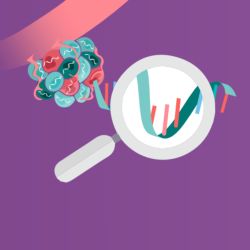Share
Talking Techniques
The latest in lab updates and life science developments
Latest episode

3. Spatial analysis of the immune-cell-surface proteome at a single-cell resolution
23:58The cell-surface proteome plays a critical role in immune-cell function; however, our ability to examine its interactions and spatial organization has previously been limited by available proteomic techniques. This episode explores the function of immune-cell membrane proteins and how the latest developments in spatial proteomics have enabled more detailed interrogation of these proteins and their spatial relationships.Our guest, Hanna van Ooijen, Immunology Application Scientist at Pixelgen Technologies guides us through the field, revealing a new technique that enables spatial analysis of the cell-surface proteome at a single-cell resolution and highlighting some exciting discoveries that it has facilitated.Contents:Introductions: 00:00-01:40Introducing Molecular Pixelation: 01:40-02:15Example applications of Molecular Pixelation: 02:15-03:20The role of membrane proteins in immune cell function: 03:20-07:25Traditional techniques to investigate cell membrane proteins: 07:15-10:20Recent improvements in investigative technology and our understanding of immunology: 10:20-11:10Challenges associated with current technologies: 11:10-13:50How Molecular Pixelation can address these challenges: 13:50-15:25Molecular Pixelation workflow: 15:25-17:55Tips for best practice when using molecular pixelation: 17:55-19:30Exciting discoveries using Molecular pixelations: 19:30-21:00Potential implications of molecular pixelation for the future of immunology: 21:00-24:00
More episodes
View all episodes

2. Investigating the neurological pathways underlying vocal communication
34:27In this episode of Talking Techniques, we catch up with Michael Long, Principle Investigator of the Long Lab at New York University (NY, USA), where he investigates the neural circuits that underlie vocal communication.Through the examination of animal models, from songbirds to the rare singing mice of Costa Rica, with cutting-edge imaging techniques Michael reveals fascinating insights into vocal communication. We also discuss his human experiments, working alongside neurosurgeons, with emerging electrophysiological probes to monitor the neural activity of participants as they speak and interact, ultimately revealing how this research could begin to provide solutions for neurological conditions impacting communication, such as autism.Contents:Introduction: 00:00 – 01:40Investigating neural circuits underlying vocal communication: 01:40 – 04:15Techniques to explore animal models of vocal communication: 04:15 – 06:25The impact of cooling brain regions on songbird singing: 06:25 – 07:50The techniques used to investigate animal models: 07:50 – 12:20Songbirds: 07:50 – 09:45The singing mouse: 10:00 – 12:20Investigating neural circuits in humans during speech: 12:20 – 16:30Investigating neural circuits in humans during conversation: 16:30 – 19:00Moving beyond neural area identification towards understanding neural pathways and mechanisms: 19:00 – 21:40Navigating neuropixels, big data and safety: 21:40 – 26:10If there was one thing you could ask for to help you better understand these pathways, what would it be? 26:10 – 27:55The experience of working with patients undergoing neurosurgery: 27:55 – 30:30The potential impact on speech disorders and autism: 30:30 – 33:15
1. Rare disease and pharmacogenomics
20:18Launching our fourth season of Talking Techniques, this episode, supported by the University of Cincinnati (OH, USA) we delve into rare disease research and pharmacogenomics, their intersection and the key techniques used to explore them.Guiding us through these fields is Brenna Carey, an Assistant Professor at Cincinnati Children’s Hospital Medical Center whose research focuses on rare disease pathogenesis, diagnostics and therapeutic development and who also runs key courses on the University’s Pharmacogenomics and Drug Discovery Masters degree programs.Contents:Introduction: 00:00-01:15An introduction to pulmonary alveolar proteinosis (PAP) and rare lung diseases 01:15-03:50Techniques to investigate the pathogenesis of PAP: 03:50-05:30Developing diagnostics and therapeutics for PAP: 05:30-08:20The importance of pharmacogenomics in drug development: 08:20-11:25Key techniques and approaches in pharmacogenomics: 11:25-13:00Emerging trends in pharmacogenomics: 13:00-15:05Key takeaways from your pharmacogenomics course: 15:00-18:00What would you ask for to improve our understanding of pharmacogenomics? 18:00-20:15This episode is supported by the University of Cincinnati Online
9. One man’s waste in another man’s treasure: using wastewater to monitor infectious diseases
20:47In this episode of Talking Techniques, we talk to Andrew Lee, a senior research fellow in Queen’s University Belfast’s (UK) wastewater-based epidemiology group, about his work using wastewater to monitor and detect infectious diseases. Andrew discusses how wastewater surveillance acts as an early warning system, providing novel, unbiased insights into human and animal pathogens that are circulating within a community, and how this can contribute to a ‘One Health’ approach. He also explains how he has incorporated nanopore sequencing into his work, and the advantages that this provides.Contents:· 00:00–01:45: Introductions· 01:45–03:45: Wastewater surveillance for infectious disease· 03:45–05:35: Genomic surveillance approaches can complement established epidemiological methods· 05:35–07:25: Why look at wastewater?· 07:25–10:40: The advantages of nanopore sequencing for wastewater surveillance· 10:40–12:25: The experimental workflow· 12:25–15:05: Using wastewater surveillance to detect both human and avian influenza· 15:05–18:20: Wastewater surveillance as an early warning system· 18:20–20:47: Future perspectives: other environmental samples, antimicrobial resistance and what else can be found in wastewater?
8. Next-generation antibody therapeutics
24:52In this episode of Talking Techniques, we speak to two experts from Sino Biological US Inc. (PA, USA) about the latest developments in antibody technologies and how these developments have led to the next generation of antibodies that are revolutionizing therapeutic approaches to a number of diseases.With the guidance of Field Scientist Ritwika Biswas and Technical Account Manager Grace Liu, we explore the challenges of developing and working with next-generation antibodies, the latest developments and applications of these molecules and the holy grail that antibody designers are driving towards.Contents:Introduction: 00:00 – 02:40The history of monoclonal antibody therapeutics: 02:40 – 04:40The working principles of multi-specific antibodies: 04:40 – 08:15Recent developments in ADCs: 08:15 – 11:35Challenges with the development of multi-specific antibodies and ADCs: 11:35 – 13:55Solutions to address these challenges: 13:55 – 16:25Clinical applications of multi-specific antibodies and ADCs: 16:25 – 20:30The dream of real-time adaptability for the next generation of antibody therapeutics: 20:30 – 24:52
7. Investigating resistant leukemia with single-cell technologies
09:50In this episode of Talking Techniques, Rachel Thijssen, an Assistant Professor at Amsterdam University Medical Centers (UMC; the Netherlands), discusses her research using single-cell analyses to investigate treatment-resistant leukemia cells. Rachel explains her single-cell technique called rapid capture hybridization sequencing (RaCH-seq), how she utilizes nanopore sequencing, and how she hopes that this technique can be used to gain new insights into disease and improve therapies. Contents:00:00–01:35: Introduction 01:35–03:25: Single-cell sequencing in leukemia research03:25–05:15: What is single-cell RaCH-seq?05:15–06:10: Using nanopore sequencing for RaCH-seq06:10–07:30: How can other researchers apply RaCH-seq to their work?07:30–09:50: Looking to the future: spatial biology, collaborations and improved therapies
6. CAR-T and CAR-NK cell therapies
27:35In this episode of Talking Techniques, Ritwika Biswas, Field Scientist at Sino Biological US Inc. (PA, USA), walks us through the chimeric antigen receptor (CAR) development process and how T and natural killer (NK) cells can be utilized to carry these modular synthetic molecules. Ritwika also addresses the safety and efficacy of these cell therapies as well as the ethical considerations around them.